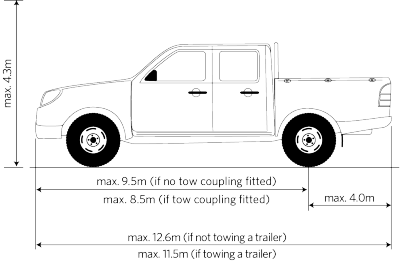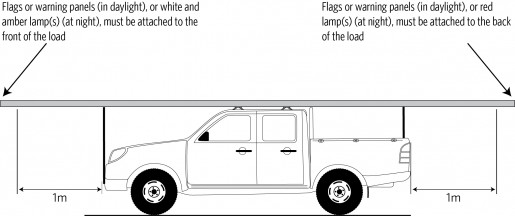This page describes the legal requirements in the Land Transport Rule: Vehicle Dimensions and Mass 2016 relating to the dimension limits for light rigid vehicles.
Also read Vehicle dimensions and mass: general information.
Light vehicles are those with a maximum gross vehicle mass (GVM, usually specified by the manufacturer) of 3500 kilograms or less.
A rigid vehicle has at least two axles, a driver’s position, a steering system, motive power (pedals or a motor to drive the wheels) and a single rigid chassis.
Light rigid vehicles include cycles, mopeds, motorcycles, cars, light vans, light mobile homes, light forklifts, light tractors, and light self-powered agricultural and light construction machines.
The definitions of length depend on the definitions of rear axis and wheelbase which vary with different vehicle design configurations.
The maximum height above ground is 4.3 metres.
The maximum width for a rigid vehicle with two wheels is 1.1 metres. The maximum width for a vehicle with three or more wheels is 2.55 metres or 1.275 metres from each side of the longitudinal centre line of the vehicle (excluding side marker lights, direction indicators and the bulge towards the bottom of a tyre).
The only extra width you’re allowed is:
240 millimetres each side for collapsible mirrors, and 1.49m when measured from the vehicle’s longitudinal centre line
cab exterior grabrails that extend not more than 1.325m when measured from a vehicle’s longitudinal centre-line (to help the driver and passengers get in and out safely)
cameras or close-proximity monitoring systems mounted on the side exterior of a vehicle that extends not more than 70mm from the side wall of the vehicle;
devices for improving the aerodynamic performance of a vehicle that extend not more than 25mm from either side of a vehicle.

The maximum length for a light rigid vehicle not towing a trailer is 12.6 metres (including any load). However, the maximum length for a rigid vehicle towing a trailer is 11.5 metres (including any load). This means that if your vehicle is longer than 11.5 metres you cannot tow a trailer or other vehicle.
Forward distance for a rigid vehicle means the distance from the rear axis to the front of the vehicle or its load, whichever is foremost (excluding collapsible mirrors).
The maximum forward distance for rigid vehicles without a tow coupling is 9.5 metres. Rigid vehicles with a tow coupling are restricted to a maximum forward distance of 8.5 metres. This assumes that the vehicle will be towing at some time and the forward distance then cannot exceed 8.5 metres.
Rear overhang means the distance from the rear axis to the rear of the vehicle or its load, whichever is greater. It depends on the definitions of rear axis. For a rigid vehicle without a rear steering axle, the maximum rear overhang is 4 metres.
There is no minimum ground clearance requirement for light rigid vehicles. If a light motor vehicle’s suspension is modified so the ground clearance is less than 100 millimetres, the modified suspension must be approved by a low volume vehicle certifier.
The maximum front overhang (measured from the front edge of the driver’s seat when in its rearmost position to the foremost point of the vehicle or its load) is three metres (except for an agricultural motor vehicle where four metres is allowed).
A vehicle (including projections) must be able to complete a 360 degree turn, both to the left and to the right, within a circle with a wall-to-wall diameter of 25 metres. The only projections that can be outside this circle are collapsible mirrors.
Vehicles may carry loads that are higher, longer or wider than the dimensions of the vehicle itself, provided that the load doesn’t exceed the maximum permitted dimensions for that class and type of vehicle. The vehicle must be able to be moved safely when so loaded. It’s the operator’s responsibility to ensure the load is properly secured to the vehicle so that the vehicle remains stable at all times.
|
Please note: you might need an overdimension permit if the load exceeds any of the standard dimension limits. Find out more about overdimension permits |

Loads that overhang the outside of the body or deck of the vehicle by more than one metre to the front or rear, or more than 200 millimetres to the left or right side, need to carry special warning devices attached to the overhanging end(s) of the load as follows.
During the hours of daylight, there must be:
a clean white, or fluorescent red, orange or yellow flag, at least 400 millimetres long by 300 millimetres wide, or
a hazard warning panel, at least 400 millimetres long by 300 millimetres wide showing an orange diagonal stripe (200 millimetres wide) against a yellow-green background, facing forwards or rearwards, or
a hazard warning panel, at least 300 millimetres long by 400 millimetres wide showing an orange diagonal stripe (200 millimetres wide) against a yellow-green background, facing forwards or rearwards, or
a hazard warning panel, at least 600 millimetres high by 200 millimetres wide showing an orange diagonal stripe (300 millimetres wide) against a yellow/green background facing forwards or rearwards
Note: Hazard warning panels that extend beyond the edge of the vehicle must be frangible (breakable or readily deformable).
During the hours of darkness, the flags or hazard panels may be displayed and lights must be attached to the load as follows. For loads:
over one metre wide and extending more than one metre from the rear of the vehicle, one red lamp (facing toward the rear) on each side of load
up to one metre wide and extending more than one metre from the rear of the vehicle, one red lamp (facing toward the rear) at the centre of load
over one metre wide and extending from the front of the vehicle, one white or amber lamp (facing toward the front) on each side of load
up to one metre wide and extending more than one metre from the front of the vehicle, one white or amber lamp (facing toward the front) at the centre of load
extending more than 200 millimetres beyond the side of the body of the vehicle, one red lamp (facing toward the rear) on each side of the load at the rear and one white or amber lamp (facing toward the front) on each side of the load at the front.
These lights must be clearly visible in clear weather at a distance of at least 200 metres during the hours of darkness. Displaying these lights at night is an operating requirement. It applies to all vehicles, no matter when they were first registered.